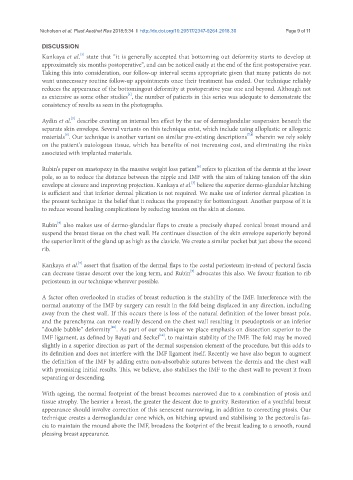Page 246 - Read Online
P. 246
Nicholson et al. Plast Aesthet Res 2018;5:34 I http://dx.doi.org/10.20517/2347-9264.2018.30 Page 9 of 11
DISCUSSION
[3]
Kankaya et al. state that “it is generally accepted that bottoming out deformity starts to develop at
approximately six months postoperative”, and can be noticed easily at the end of the first postoperative year.
Taking this into consideration, our follow-up interval seems appropriate given that many patients do not
want unnecessary routine follow-up appointments once their treatment has ended. Our technique reliably
reduces the appearance of the bottomingout deformity at postoperative year one and beyond. Although not
[4]
as extensive as some other studies , the number of patients in this series was adequate to demonstrate the
consistency of results as seen in the photographs.
[5]
Aydin et al. describe creating an internal bra effect by the use of dermoglandular suspension beneath the
separate skin envelope. Several variants on this technique exist, which include using alloplastic or allogenic
[6]
[7,8]
materials . Our technique is another variant on similar pre-existing descriptions wherein we rely solely
on the patient’s autologous tissue, which has benefits of not increasing cost, and eliminating the risks
associated with implanted materials.
[9]
Rubin’s paper on mastopexy in the massive weight loss patient refers to plication of the dermis at the lower
pole, so as to reduce the distance between the nipple and IMF with the aim of taking tension off the skin
[3]
envelope at closure and improving projection. Kankaya et al. believe the superior dermo-glandular hitching
is sufficient and that inferior dermal plication is not required. We make use of inferior dermal plication in
the present technique in the belief that it reduces the propensity for bottomingout. Another purpose of it is
to reduce wound healing complications by reducing tension on the skin at closure.
[9]
Rubin also makes use of dermo-glandular flaps to create a precisely shaped conical breast mound and
suspend the breast tissue on the chest wall. He continues dissection of the skin envelope superiorly beyond
the superior limit of the gland up as high as the clavicle. We create a similar pocket but just above the second
rib.
[3]
Kankaya et al. assert that fixation of the dermal flaps to the costal periosteum in-stead of pectoral fascia
[9]
can decrease tissue descent over the long term, and Rubin advocates this also. We favour fixation to rib
periosteum in our technique wherever possible.
A factor often overlooked in studies of breast reduction is the stability of the IMF. Interference with the
normal anatomy of the IMF by surgery can result in the fold being displaced in any direction, including
away from the chest wall. If this occurs there is loss of the natural definition of the lower breast pole,
and the parenchyma can more readily descend on the chest wall resulting in pseudoptosis or an inferior
[10]
“double bubble” deformity . As part of our technique we place emphasis on dissection superior to the
[10]
IMF ligament, as defined by Bayati and Seckel , to maintain stability of the IMF. The fold may be moved
slightly in a superior direction as part of the dermal suspension element of the procedure, but this adds to
its definition and does not interfere with the IMF ligament itself. Recently we have also begun to augment
the definition of the IMF by adding extra non-absorbable sutures between the dermis and the chest wall
with promising initial results. This, we believe, also stabilises the IMF to the chest wall to prevent it from
separating or descending.
With ageing, the normal footprint of the breast becomes narrowed due to a combination of ptosis and
tissue atrophy. The heavier a breast, the greater the descent due to gravity. Restoration of a youthful breast
appearance should involve correction of this senescent narrowing, in addition to correcting ptosis. Our
technique creates a dermoglandular cone which, on hitching upward and stabilising to the pectoralis fas-
cia to maintain the mound above the IMF, broadens the footprint of the breast leading to a smooth, round
pleasing breast appearance.

